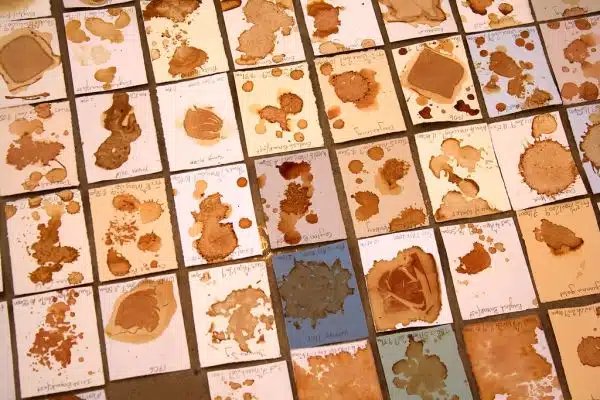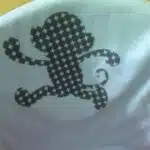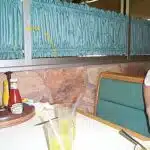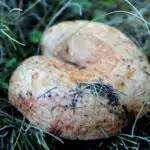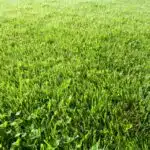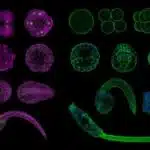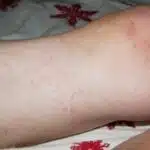Tea is a popular beverage worldwide, with millions of people consuming it regularly. Although tea is known for its numerous health benefits, it can also pose some challenges when it comes to removing stains from clothing or carpets. As a professional cleaning expert, I have encountered countless clients struggling with stubborn tea stains that seem impossible to remove. Luckily, there are several proven methods for removing tea stains effectively, and in this article, we will explore some of the most effective techniques.
Removing tea stains requires patience and attention to detail. Whether you’re dealing with fresh or old tea stains on your favorite blouse or carpet, the key is to act quickly and use the right cleaning products and techniques. In this article, we will discuss some of the most common types of tea stains and how to treat them effectively using items you probably already have at home. By following these tips, you’ll be able to remove even the toughest tea stains and restore your fabric or carpet to its former glory.
Common Types Of Tea Stains
Tea stains are a common household nuisance that can be tricky to remove. They can leave unsightly marks on various surfaces, from carpets to clothes and upholstery. There are different types of tea stains, with black and green tea being the most common. Black tea stains tend to be darker and more stubborn compared to green tea stains.
To identify a black tea stain, look for its deep brown color and slightly bitter aroma. On the other hand, green tea stains are lighter in color, with a yellowish-green hue and a mild grassy scent. Knowing how to differentiate between the two types of tea stains is essential in determining the best cleaning solution.
Removing tea stains requires quick action regardless of the type of surface. The longer you wait before treating it, the harder it becomes to remove the stain completely. It is important to address the stain as soon as possible before it sets into the fibers or pores of the surface material. In the next section, we will discuss why quick action is key when dealing with tea stains and how to remove them effectively.
Quick Action Is Key
Identifying tea stains can be done by looking for a yellow or brown discoloration on fabric or other surfaces. Removing tea stains requires quick action, as they can become more difficult to remove with time. To remove a tea stain, first use cold water to flush the stain and then apply a gentle detergent. Finally, rinse and repeat as necessary, as some stains may require multiple treatments.
Identifying The Stains
Tea stain removal techniques are not universal, and they can differ depending on the material to which the stain is attached. Identifying the stains is a crucial step in determining the appropriate cleaning method. There are various factors that affect tea stain removal efficiency, such as the age of the stain, type of fabric, and water temperature.
When dealing with tea stains on clothing, it is essential to determine the type of fabric involved. Some fabrics may require specialized treatment methods to avoid damage or discoloration. Additionally, factors such as heat and agitation can impact the success of removing tea stains from clothing. Therefore, it is necessary to identify these factors before proceeding with any cleaning techniques.
For non-clothing items such as carpets or upholstery, identifying tea stains requires a different approach. The age of the stain plays a significant role in determining its removal efficiency. Fresh tea stains are easier to remove than those that have been sitting for an extended period. It is also crucial to consider factors such as colorfastness and fiber content when attempting to remove tea stains from carpets or upholstery. By identifying these factors, one can choose an appropriate cleaning technique that will effectively remove the tea stain without damaging the surface.
Removing The Stains
As a professional cleaning expert, one of the most important things to understand about tea stains is that quick action is key. The longer a stain sits, the harder it becomes to remove. Reducing the amount of time that a stain has to set can significantly increase the effectiveness of any cleaning method.
Tea stain prevention is always the best course of action, but accidents happen. When dealing with a fresh tea stain on clothing, blotting with a clean cloth or paper towel can help absorb excess liquid and prevent the stain from spreading. It’s essential to avoid rubbing or scrubbing the stain, as this can force it deeper into the fabric fibers and make it more difficult to remove. There are also specialized tea stain removal products available that can be used safely on most fabrics. These products should be used according to their instructions and tested on an inconspicuous area first to ensure they won’t cause damage or discoloration.
For non-clothing items such as carpets or upholstery, prompt action is even more critical. Tea stains left in carpet fibers or upholstery for extended periods can become deeply embedded and require professional cleaning services for removal. In some cases, it may be possible to use home remedies such as white vinegar or baking soda mixed with water to lift fresh stains before they have a chance to set. However, these methods should only be used after identifying factors such as colorfastness and fiber content carefully. Using inappropriate cleaning methods could result in permanent damage to carpets or furniture.
Blotting The Stain
Quick action is key in removing tea stains, as allowing the stain to set will make it harder to remove. As soon as the spill occurs, use blotting techniques to absorb excess liquid from the surface of the fabric. This is important because it will prevent the liquid from spreading and setting further into the material.
Blotting techniques are essential in removing tea stains on fabric surfaces. The goal is to lift as much of the stain as possible without rubbing or scrubbing vigorously, which can damage delicate fabrics. Use absorbent materials such as paper towels, clean cloth or a sponge that has been dampened with cold water for best results. Gently apply pressure on the affected area and repeat until no more liquid can be extracted.
To ensure complete removal of tea stains, rinse with cold water after blotting. Coldwater helps to loosen any remaining residue and prevents further staining by setting the stain into the fabric. Rinse thoroughly until all traces of soap and tea have been removed before washing it using your preferred method. Remember not to use hot water when rinsing because it will set-in stains making them even harder to remove.
- Act quickly
- Blot gently
- Use absorbent materials such as paper towels, clean cloth or sponge
- Repeat process until no more liquid can be extracted
- Rinse with cold water
By following these simple steps for removing tea stains, you can restore your fabrics to their original condition in no time! Remember that prompt action combined with proper blotting techniques followed by rinsing with cold water is key to successful stain removal. With these tips and tricks in mind, you’ll be able to tackle any tough tea stains that come your way!
Rinsing With Cold Water
- Cold water is an effective and inexpensive way to remove tea stains from clothing and other materials.
- Removing tea stains with cold water is a simple process that can be done without the use of harsh chemicals or specialized cleaning products.
- Rinsing tea stains with cold water can help to prevent further staining and discoloration of the fabric.
- Additionally, cold water rinse is beneficial as it reduces the risk of damage to the material, while still providing effective cleaning.
Removing Tea Stains With Cold Water
Removing tea stains can be a challenging task, especially if the stain has set in. Fortunately, there are several effective methods for removing tea stains from fabrics and surfaces. One of the most straightforward and efficient techniques is rinsing with cold water.
When it comes to removing tea stains, using cold water is preferable to hot water. This is because hot water can set the stain and make it more challenging to remove. Coldwater, on the other hand, helps to loosen the stain and prevent it from setting into the fabric or surface. To begin this method, start by running cold water through the backside of the stained area until it begins to fade away.
Tea stain prevention is always better than cure. However, assuming that a stain has already occurred, immediate action must be taken to avoid permanent damage. Rinsing with cold water should be done as soon as possible after spilling tea on any surface or fabric. This will help prevent further penetration of the stain and make it easier for subsequent cleaning methods to eliminate all traces of the tea stain.
Benefits Of Rinsing Tea Stains With Cold Water
When it comes to removing tea stains, rinsing with cold water is an effective way to prevent the stain from setting in. However, aside from this general knowledge, there are specific benefits of using cold water that every tea drinker should know.
Firstly, rinsing with cold water helps preserve the taste and aroma of tea. Tea experts recommend using cold water when brewing delicate teas such as green and white tea. Similarly, applying cold water when removing tea stains prevents the fabric or surface from getting damaged by heat. This is particularly important for fabrics that can easily shrink or warp under high temperatures.
Secondly, using cold water is a cost-effective way to remove tea stains compared to other cleaning methods. Coldwater is readily available and doesn’t require any additional cleaning products or equipment. This makes it a convenient option for people who want a quick solution without having to spend too much money.
By now, you may be wondering how to make the perfect cup of tea that doesn’t leave any stubborn stains behind. The key is in brewing your tea correctly by following expert tips such as using the right temperature and steeping time for your chosen type of tea. But if you do happen to spill some on your clothes or furniture, remember that rinsing with cold water will help preserve the taste of your favorite beverage while effectively removing the stain at the same time.
Soaking In A Solution
You’ve just finished enjoying a cup of tea, and now you’re left with a stubborn stain on your clothing or tablecloth. How frustrating! But fear not, as there is a solution that will make removing those tea stains a breeze. The secret? Soaking the affected area in a solution.
The benefits of soaking are numerous when it comes to removing tea stains. Firstly, it allows the solution to penetrate deep into the fibers of the material, breaking down the stain from the inside out. Secondly, soaking gives time for the chemical reaction between the cleaning agents and the stain to occur, making it easier to remove. Lastly, it requires minimal effort on your part – all you need to do is leave the item to soak and let science do its job.
Different soaking solutions work best for different types of stains and materials. For tea stains specifically, there are several options you can try. One simple solution is to mix equal parts white vinegar and water and soak your item in this mixture for at least an hour before washing as usual. Another option is to use lemon juice mixed with water instead of vinegar, which also works well on tea stains.
Now that we’ve covered how soaking can help remove those pesky tea stains, let’s move onto another effective method: using baking soda.
Using Baking Soda
To effectively remove tea stains from your clothing or tablecloth, soaking in a solution can be an effective method. However, if this method does not completely remove the stain, using baking soda may be the next option to consider. Baking soda is a versatile cleaning agent that has been used for centuries due to its effectiveness in removing stains and odors.
Benefits of Baking Soda in Cleaning:
- Naturally abrasive: Baking soda’s texture makes it an excellent abrasive cleaner that can scrub away tough stains without damaging surfaces.
- Neutralizes odors: Baking soda is known for its ability to neutralize unpleasant odors by absorbing them.
- Versatile cleaning agent: In addition to removing tea stains, baking soda can also clean carpets, kitchen appliances, and even teeth.
Baking Soda vs. Other Cleaning Agents: Compared to other cleaning agents such as bleach or ammonia, baking soda is a safer and more environmentally friendly option. Bleach and ammonia are known for their harsh chemicals that can cause skin irritation and respiratory problems when inhaled. Additionally, both bleach and ammonia release harmful fumes into the air during use. On the other hand, baking soda is non-toxic and safe to use around children and pets.
Incorporating baking soda into your cleaning routine can not only effectively remove tea stains but also provide numerous benefits over other cleaning agents. In the next section, we will explore another natural cleaning solution: vinegar. Vinegar is commonly used as a household cleaner due to its acidity level which makes it effective in dissolving grease and grime on various surfaces.
Applying Vinegar
One effective method for removing tea stains is by using vinegar. Vinegar is a natural cleaning agent that has acidic properties, making it a powerful stain remover. To apply vinegar, mix one part white vinegar with two parts water and dip a clean cloth in the solution. Then, dab the cloth onto the stained area until the stain disappears.
Alternative methods for removing tea stains include using baking soda or lemon juice. Baking soda can be mixed with water to form a paste that can be applied directly onto the stain. Lemon juice can also be used by soaking the stained item in lemon juice for several minutes before washing it as usual. However, these alternative methods may not be as effective as using vinegar.
When comparing effectiveness among different methods of removing tea stains, it is important to consider the type of stain and material being treated. While some methods may work well on certain fabrics, they may not work on others. Additionally, some stains may require multiple treatments or a combination of methods for complete removal. It is recommended to test any method on a small, inconspicuous area first before treating the entire stain.
Transitioning into trying hydrogen peroxide without using ‘step’, another effective method for removing tough tea stains is by using hydrogen peroxide. Hydrogen peroxide works by breaking down the chemical bonds of the stain molecules and lifting them from the fabric fibers. To use hydrogen peroxide, mix equal parts hydrogen peroxide and water and apply it directly onto the stained area with a clean cloth or sponge. Let it sit for a few minutes before rinsing it off with cold water and washing as usual.
Trying Hydrogen Peroxide
Like a magic wand, hydrogen peroxide can remove even the toughest tea stains. Its bubbling action penetrates deep into the fabric and lifts the stain away, leaving behind a spotless surface. While it may not work on all types of tea stains, it is a reliable option to try before giving up on your stained garment.
Using peroxide for tea stain removal requires careful attention to detail. Here are some tips to keep in mind:
- Make sure to test the solution on an inconspicuous area of the fabric before applying it directly to the stain. This will help ensure that it does not cause any discoloration or damage.
- Seeing the stain start to disappear can be satisfying, but avoid rubbing or scrubbing too vigorously as this can damage the fabric fibers.
Overall, hydrogen peroxide is an effective solution for removing many types of tea stains. From black tea to green tea, its powerful cleaning properties make it a go-to choice for many cleaning experts. However, if you find that peroxide is not effective for your particular stain, don’t worry! There are still other options available to try. Next up: using lemon juice as a natural alternative for removing stubborn tea stains.
Using Lemon Juice
Lemon juice has been used for centuries as a natural cleaning agent due to its acidic properties. It can be an effective solution for removing tea stains as well. The benefits of using lemon juice for cleaning are numerous, including its ability to eliminate stubborn stains, disinfect surfaces and leave a refreshing citrus scent.
Compared to other stain removers, lemon juice is a safer and more eco-friendly option. Many commercial cleaning products contain harsh chemicals that can be harmful to the environment and cause health issues in humans and pets. In contrast, lemon juice is non-toxic and biodegradable, making it a healthier alternative that is also cost-effective.
To use lemon juice for removing tea stains, simply apply it directly onto the affected area and let it sit for 5-10 minutes. Then, rinse with water and repeat if necessary. For tougher stains, you can mix lemon juice with salt or baking soda to create a natural abrasive that will scrub away even the most stubborn marks.
Applying salt after using lemon juice is another effective method of removing tea stains. Salt acts as an absorbent material that helps lift the stain from the fabric or surface. Sprinkle salt over the stained area and let it sit for a few minutes before wiping away with a damp cloth. With these simple steps, you can remove tea stains easily and naturally without harming your health or the environment.
Applying Salt
Like a seasoned chef who expertly seasons their dishes, salt is an underrated ingredient that can be used in various ways to clean and remove stubborn stains. When it comes to removing tea stains, salt is an effective cleaning agent that can be easily found in every household. Its unique texture and chemical properties make it ideal for breaking down the tannins found in tea stains.
Benefits of Salt as a Cleaning Agent:
- Salt is a gentle yet effective abrasive that helps to lift and scrub away dirt and grime.
- It has natural deodorizing properties that can help to neutralize unpleasant odors.
- Salt is non-toxic and environmentally friendly, making it a safer alternative to harsh chemicals.
- It’s affordable and easily accessible, which makes it a convenient solution for quick stain removal.
- Using salt as a cleaning agent leaves behind no residue or harmful chemicals that could harm surfaces or fabrics.
Using Salt to Remove Other Stains: In addition to tea stains, salt can be used to remove other types of stains such as wine, coffee, blood, and even ink. To use salt for stain removal, follow these simple steps:
- Dampen the stained area with water
- Sprinkle salt generously over the affected area
- Gently rub the salt into the stain using a soft-bristled brush or cloth
- Let the salt sit on the stain for 5-10 minutes
- Rinse the area with water until all of the salt has been removed
By using this method, you’ll find that most of your stubborn stains will disappear without any hassle.
Transition: If you find that the tea stain still persists after using salt, don’t worry! There’s another cleaning agent that we recommend trying: dish soap.
Trying Dish Soap
After applying salt to the tea stain, you may find that it has lightened but not completely disappeared. In this case, there are alternative methods to consider. One such method is trying dish soap.
To remove tea stains with dish soap, begin by moistening the stained area with cold water. Then apply a small amount of dish soap directly onto the stain and gently rub it in using a clean cloth or sponge. Allow the soap to sit for a few minutes before rinsing with cold water. Repeat the process until the stain has been lifted.
When comparing effectiveness between salt and dish soap, it ultimately depends on the severity of the stain and material of the affected item. Dish soap tends to be more effective on fabric materials while salt works better on hard surfaces like porcelain or ceramic. Regardless of which method you choose, always test on a small inconspicuous area first before applying to the entire stain.
To avoid setting in tea stains further, it’s important to avoid heat during any cleaning process. Heat can cause stains to set in deeper into fabrics or surfaces, making them much harder to remove later on. Instead, opt for cold water when rinsing or soaking stained items and avoid placing them in direct sunlight or near heat sources until fully dry.
Avoiding Heat
Using alternative cleaning methods can be effective in removing tea stains without the use of harsh chemicals. One method is to mix equal parts of white vinegar and water, and then apply the solution onto the affected area using a clean cloth. Allow it to sit for 10-15 minutes before rubbing gently with a soft-bristled brush. Rinse thoroughly with cold water and repeat until the stain disappears.
Another alternative method is to use baking soda. Sprinkle baking soda over the stained area, wet it with a few drops of water, and then rub it gently using a damp cloth. Leave it for 30 minutes before rinsing off with cold water. Baking soda not only helps remove the stain but also eliminates any foul odor that may have been caused by the tea.
When attempting to remove tea stains, one must be cautious about preventing heat damage to fabrics as this can cause further discoloration or damage to materials such as silk or wool. Avoid using hot water or exposing fabrics to high temperatures such as those from irons or dryers. Instead, opt for lukewarm water and air-drying methods.
Tips for avoiding heat damage:
- Always read care labels on fabric items
- Use cold water when washing
- Air-dry fabrics instead of putting them in dryers
- Iron at low temperature settings
- Avoid exposing fabrics to direct sunlight
Testing on a hidden area before applying any cleaning solution is essential in preventing further damage or discoloration on fabrics. In addition, one must avoid using harsh chemicals that may harm both the material and environment while trying to remove tea stains from fabrics. By employing these alternative cleaning methods and following these precautions, one can effectively remove stubborn tea stains while ensuring that their clothing remains unharmed.
Testing On A Hidden Area
1.When conducting a test to remove tea stains from a hidden surface, it is important to first identify an inconspicuous spot to test the cleaning agent. 2.Before testing the cleaning agent, it is necessary to pre-clean the test spot in order to ensure an accurate test of the removal of the tea stain. 3.When testing for safe removal of the tea stain, the cleaning expert should take into account the pH balance of the cleaning agent, as well as the type of fabric or surface the tea stain is on. 4.The cleaning expert should also consider the type of tea stain in order to assess the best method for removal. 5.To ensure a safe removal of the tea stain, the cleaning expert should consider the degree of discoloration, the age of the stain, and the type of fabric or surface it is on. 6.The cleaning expert should also consider the effects of the cleaning agent on the fabric or surface and the environment.
Choosing A Test Spot
Removing tea stains from fabrics and surfaces can be quite challenging. Before attempting to remove the stain, it is essential to choose a test spot on the material or surface. This step is crucial as it helps prevent further damage or discoloration. It is also an opportunity to determine the effectiveness of a cleaning solution before applying it to the entire area.
The importance of patience cannot be overstated when choosing a test spot for tea stain removal. Rushing through this process may lead to irreversible damage, which can be costly to repair. Taking time with each step will ensure that you achieve the desired results without damaging your fabric or surface.
When mixing cleaning solutions, it is vital to read and follow the manufacturer’s instructions carefully. Failure to do so may result in using too much of one ingredient or not enough of another, leading to unsatisfactory results. Properly mixed cleaning solutions will help remove even stubborn tea stains effectively.
In conclusion, choosing a test spot when removing tea stains is an essential step that should not be overlooked. It helps prevent damage or discoloration and determines the effectiveness of cleaning solutions before application. Patience and proper mixing of cleaning solutions are critical factors that should be considered during this process for optimal results.
Pre-Testing Cleaning Agents
When it comes to cleaning tea stains, pre-testing cleaning agents is a crucial step in ensuring that the chosen solution will be effective and safe for the fabric or surface. Testing the effectiveness of different cleaning agents can help determine which one will work best on the stain without causing any damage. This process involves applying a small amount of the cleaning agent to an inconspicuous area of the material or surface and waiting to see if any adverse reactions occur.
Choosing appropriate agents for pre-testing is also essential. Different fabrics require different cleaning solutions, so it is important to research which ones are safe and effective for each type of material. It’s also essential to avoid using harsh chemicals or bleach-based products that could cause discoloration or damage. Instead, opt for gentle cleaners that are specifically designed for removing tea stains.
In addition to testing the effectiveness of different cleaning agents, it’s also important to consider how long they should be left on the fabric or surface before rinsing them off. Some cleaners may need more time to penetrate the stain, while others may need less time before being rinsed away. By taking these factors into account during pre-testing, you can ensure that your chosen cleaning agent will effectively remove tea stains without causing any further damage or discoloration.
Testing For Safe Removal
As a professional cleaning expert, it is crucial to ensure safe removal of tea stains without causing any damage to the fabric or surface. One way to do this is by testing for safe removal before applying any cleaning agent. Testing for safe removal involves applying a small amount of the cleaning agent on a hidden area and waiting to see if any adverse reactions occur.
Timing is an essential factor when testing for safe removal. Different cleaners require different amounts of time to penetrate the stain effectively. It’s important to follow the instructions provided by the manufacturer and leave the cleaner on for the recommended amount of time. Leaving the cleaner on for too long can cause discoloration or damage, while not leaving it on long enough may result in ineffective stain removal.
There are different types of testing that one can perform when testing for safe removal. Spot testing involves applying a small amount of the cleaning agent directly onto the stained area, while full immersion testing involves soaking the entire fabric in a solution containing the cleaner. Both types of testing are effective in determining which cleaning agent works best without damaging the material or surface. By performing these tests, you can be confident that your chosen cleaner will effectively remove tea stains without causing any harm.
Knowing When To Call A Professional
Determining when to hire professional cleaning services can be a tough decision. Many homeowners are hesitant to call in the experts because they believe they should be able to handle all cleaning tasks themselves. However, there are times when calling in a professional is the best option.
The first factor to consider is the size and complexity of the stain or mess. For example, if you spill a small amount of tea on your carpet, you may be able to clean it up yourself using household cleaners. However, if you spill an entire pot of tea or the stain has set in for an extended period, it may be time to call in a professional. They have access to specialized equipment and cleaning solutions that are more effective than household products.
Another factor to consider is your own expertise and experience with cleaning. If you’re not confident in your ability to clean a particular area or item without causing damage, it’s best to leave it in the hands of a professional. This is especially true for delicate fabrics, carpets, and upholstery that require special care and attention.
| Factors | DIY Cleaning | Professional Cleaning |
|---|---|---|
| Size and complexity of stain/mess | Small stains can usually be handled with household cleaners | Specialized equipment and solutions may be necessary for large or complex stains |
| Expertise and experience with cleaning | Confident DIYers may be able to handle most tasks | Professionals have training and experience working with different types of materials |
Ultimately, knowing when to hire professional cleaning services comes down to weighing the costs versus benefits. While hiring a professional may cost more than doing it yourself, their expertise can save you time, effort, and potentially costly mistakes. Don’t hesitate to contact a professional if you’re unsure about how best to clean something – it’s always better to err on the side of caution.
As much as we would like our homes to remain pristine forever, accidents happen. In the next section, we’ll discuss some preventative measures you can take to reduce the likelihood of tea stains in the future.
Preventing Tea Stains In The Future
Tea stain prevention is an important aspect of keeping your surfaces clean and looking their best. There are several measures you can take to avoid tea stains in the future, such as using coasters, preventing spills, and cleaning up any spills immediately.
One effective method of preventing tea stains is by using coasters. Coasters create a barrier between the hot cup and the surface it rests on. This prevents the transfer of heat and moisture onto the surface, which can cause staining. Using coasters also adds a decorative element to your home decor.
Another way to prevent tea stains is by being mindful of spills. Avoid placing cups near the edge of tables or countertops where they are more likely to be knocked over. If you do spill something, clean it up immediately with a damp cloth or paper towel. This will prevent the liquid from seeping into the surface and causing a stain.
In summary, preventing tea stains requires some simple steps that can be easily incorporated into your daily routine. Using coasters not only protects your surfaces but also adds a decorative touch to your home decor. Being mindful of spills and cleaning them up quickly can help keep your surfaces looking their best. By following these tips, you can enjoy your favorite cup of tea without worrying about unsightly stains on your furniture or floors.
Conclusion
Tea stains can be a stubborn enemy to remove, but with the right techniques and quick action, it is possible to restore your stained clothes or carpets. The first step is identifying the type of tea stain and acting fast. Blotting the stain gently and rinsing with cold water immediately can help prevent the stain from setting in. Soaking the affected area in a solution of water and vinegar or detergent before washing can also be effective.
It is crucial to avoid using heat on tea stains as this can cause them to set permanently. Testing any cleaning solutions on a hidden area before applying them to the stain is also recommended to prevent any unwanted damage to the fabric. If all else fails, it may be necessary to call in a professional cleaning service for assistance.
For example, imagine spilling a cup of hot tea on your favorite white shirt. Quick action would involve blotting the stain with a clean cloth and running it under cold water while preparing a solution of water and vinegar. Soaking the shirt in this solution for about an hour before washing it as usual could effectively remove the stain without causing any discoloration or damage.
As a professional cleaning expert, I recommend tackling tea stains promptly using these proven techniques for best results. With these tips, you can effectively bid farewell to even the most stubborn tea stains!
Image Credits
- “Tea stains details (1)” by Unhindered by Talent (featured)

